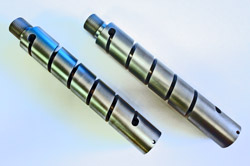
Posted to News on 8th Oct 2014, 21:53
Machined springs meet the needs of downhole measurement system
Abssac has developed a machined spring design for a customer needing to measure a compressive/tensile load of over 22kN in a very constrained spatial envelope.

Oil and gas exploration applications are, in many ways, similar to those involving equipment destined for the planet Mars: it is in a place that is inaccessible, toxic and has a corrosive environment; a place where equipment failures cannot be tolerated.
This is exactly why Abssac is having great success with its machined spring product because of its performance characteristics and proven reliability. In many of the applications within this industry a spring system is required to accurately store energy, deliver a constant force, accurately measure for deflection or perhaps act as a fail-safe component.
Wire wound springs are often used for these applications, incorporating brazed end attachments such as tangs or ground captivated end seats. In each case a single spring coil is utilised and, by the nature of the wound wire design, they have some performance limitations.
Many advantages of machined springs

Most importantly, the machined spring product can offer multi-start springs within the single-piece spring component. Offering single-, double- and triple-start configurations as standard, the product delivers exceptional performance characteristics that are unobtainable by using wire wound springs. For example, in compression, a double- or triple-start spring significantly unifies the lateral bending and lateral translation forces and moments around the spring's circumference given a lateral deflection. In the torsional mode, the machined spring can allow pure moment attachment, by incorporating specific end attachments into the single-piece design. When using integral tangs, the machined spring is without the relative stresses this type of connection can harbour.
Offering a choice of materials such as stainless steel or titanium, as well as other exotic alloys, adds strength to the argument that machined springs are a formidable product that can be used where reliability and performance are paramount.
Downhole application

The final design used three machined springs attached end-to-end to achieve a 10mm deflection for 22,241N (5000lb). The springs are constrained within a tube and the +/-10mm of linear movement is measured with a precision potentiometer.
Test results
Samples for test and evaluation were manufactured with a spring coil geometry designed to deliver the compression spring characteristics required. Two materials were used for the test samples, one using a 17-4ph stainless steel providing an axial spring rate of 6370N/mm with a variation on rate of +/-10 per cent between 0.10mm and 0.60mm compression from free length. This lower load test and rate performance theoretically proved that the required spring performance at the higher loadings would be possible. With the confidence gained from the initial tests, the maximum loading test were then carried out at the customer's premises within a test rig.
At the same time another identical spring was produced using a CC445 stainless steel, which provided the same rate and performance of +/-10 per cent, but this was to be used to compare spring rate tolerance over time in a higher-yield material. In each case the spring design incorporated a thread turned on one end and a tapped hole at the opposite end so the three springs could be assembled together to form a the final single spring system, with a total length of 650mm.
Peter Wright at Abssac states: "Whether it is a new spring application or an enhancement of an existing spring design, the machined spring product is relatively unknown by design engineers and yet has so much to offer. Many of our applications are in critical application areas where reliability, and longevity of performance are requisites."
Follow the link for more information about machined springs from Abssac.






























